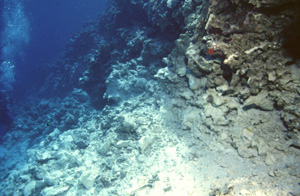|
|
Staff involved:Susan Clark, Martin LeTissier, Alasdair Edwards, Stuart Field, Catherine Michael, Ian White (International Tanker Owners Pollution Federation)Funding:NERC, International Group of P & I Clubs
Physical damage resulting from a ship grounding on a coral reef |
Temporal and spatial patterns of recovery of coral reefs from physical damageProjectThis project has a primary goal to improve the scientific understanding of reef recovery processes and the accuracy of predictions of recovery periods following physical damage. To achieve this goal the following specific objectives are being addressed using ship grounding sites of known age in both the Red Sea and Caribbean. a) Reef recovery processes and time-scales involved - our focus will be on the temporal and spatial aspects of the processes that are involved in reef recovery. We are seeking to:
b) Assessing physical and ecological damage - central to an accurate assessment of damage is the appropriateness of the methods used to make the assessment, which should be repeatable and should enable comparisons to be made with other sites. We are seeking to:
SignificanceAmongst the Earth's ecosystems coral reefs are unique in that they form durable biogenic structures that provide and support essential coastal defence, fisheries, tourism and biological diversity functions. These functions are estimated to be globally worth US$ 375 billion annually. However, coral reefs are increasingly recognised as being under serious threat from both natural and anthropogenic disturbances leading to predictions of up to 70% losses of the world's reefs in the next four decades. By far the greatest class of disturbance that threaten coral reefs are physical in nature resulting from increased frequency and severity of storms associated with climate change and anthropogenic activities such as destructive fisheries methods, mining of coral rock and construction works. Although coral reefs are viewed as being robust structures there is uncertainty regarding whether coral reefs will survive in a form that fulfils the ecological services outlined above. Central to resolving this dilemma is an understanding of the spatial and temporal processes that determine how coral reefs recover from physical perturbation. This study seeks to elucidate which of a wide range of factors that influence recovery (e.g. extent and nature of the damage; location; availability of coral larvae; survivorship of partially damaged colonies and fragments; suitability of micro-habitats available for settlement; the role of grazers; and competition with other organisms) are most important in determining recovery rates. |
